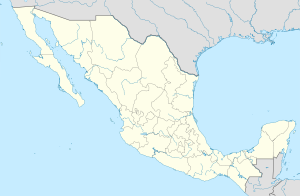Maní (Yucatán)
| Maní | ||
|---|---|---|
|
Coordinates: 20 ° 23 ′ N , 89 ° 24 ′ W Maní on the map of Mexico
|
||
| Basic data | ||
| Country | Mexico | |
| State | Yucatan | |
| Municipio | Maní | |
| Residents | 4146 (2010) | |
| Detailed data | ||
| height | 26 m | |
| Post Code | 97850 | |
| prefix | (+52) 997 | |
| Time zone | UTC −6 | |
| Franciscan monastery | ||
Maní is a village of about 4,000 people in the state of Yucatán in Mexico . Maní is the administrative seat of the Municipio Maní .
location
Maní is located in the center of the Yucatán peninsula, a good 90 kilometers (driving distance) southeast of the capital Mérida and 16 kilometers east of Ticul at an altitude of about 26 meters above sea level. d. M.
economy
In the area around Maní mainly sisal and maize as well as vegetables and fruits are grown; livestock is also farmed. Hammocks ( hamacas ) are made in the village itself .
history
Maní has been continuously inhabited for the past 4000 years. During the post-classical period , Maní was the seat of the Maya dynasty Tutul Xiu . Since the fall of Mayapán (1441), which they initiated, the Xiu had been the most powerful family among the Mayan princes and ruled over one of the largest jurisdictions in the Yucatán. This made Maní one of the most important cities in the Yucatán; as early as the 16th century, around 4,500 people lived there. In Maní there was also a religious center in honor of the deity Kukulcan , where, among other things, the fall of Mayapan was celebrated annually.
After the arrival of the Spaniards, Xiu von Maní allied himself with them in 1542 and helped them to conquer the Yucatán.
On July 12, 1562, at the instigation of the then Provincial of the Franciscan Order of Yucatán, Diego de Landa , who also exercised the office of Inquisitor , a car dairy took place in front of the San Miguel Arcángel Monastery , in which all the Mayan codes and symbols of gods were burned one could get hold of. This was done on the grounds that they only contained "lies from the devil". As a result of these and subsequent actions, only four codices of the extensive Mayan literature have survived .
Attractions
In the center of the village is the former Franciscan monastery of San Miguel Arcángel , which was founded in 1549. It was built with stones from pre-Columbian Mayan buildings and has a capilla abierta on the north side of the church facade, which is elevated by two side bell gables ( espadañas ). The single nave interior of the church houses three baroque carved altars with figures of saints and pictures; the vault of the apse is decorated with frescoes from the late colonial period.
Surroundings
The municipality of Maní also includes the village of Tipikal, only about eight kilometers to the northeast, with a beautiful colonial church from 1751.
Festivals
- Every year from August 15th to August 24th, a festival of the Assumption of Mary is organized by the residents.
- On January 3rd there are celebrations in honor of the Virgin of Candelaria .






